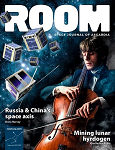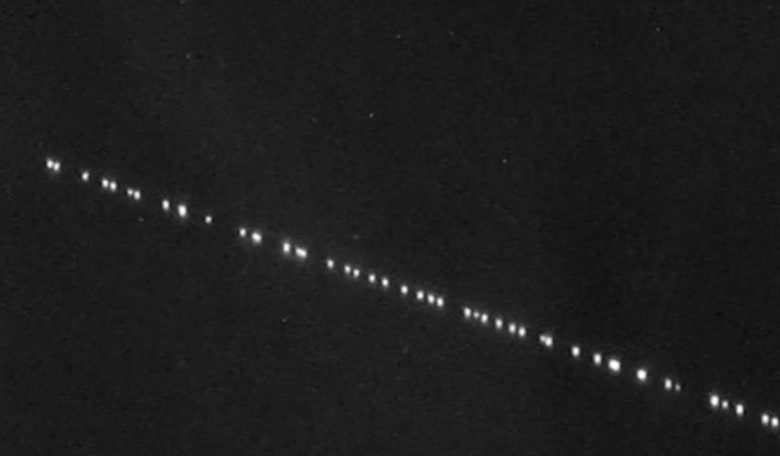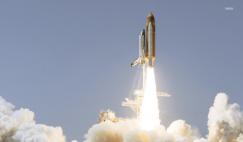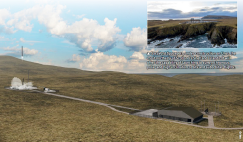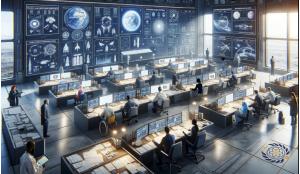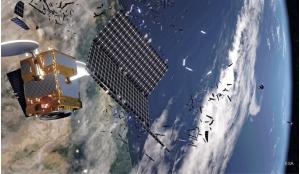Large parts of the world have an inadequate access to the internet; this can result in a lack of opportunity in at least two areas – trade and education – and this limitation is not restricted to countries that could be classed as ‘developing.’ Indeed some areas of the UK also suffer from poor broadband connection, albeit not perhaps to the same degree as those in rural Africa for example; a continent with which I have a great affinity.
Is swathing Earth with an ever-increasing large number of satellites in a megaconstellation, such as those planned by SpaceX and Jeff Bezos’s proposed Project Kuiper, the answer to the world’s internet access problems? It depends on who you ask. Astronomers for instance are very worried that their view of the night sky will be ruined, while those responsible for large observatories are concerned that vital observing time will be lost and that images will be photo bombed by unwanted streaks that mark the passage of satellite ‘trains’ whizzing past overhead.
These concerns are not just from a few select individuals, however. A brief delve into the official stance from the International Astronomical Union (IAU) echoes the same sentiment; “The International Astronomical Union (IAU) is concerned about the impact of satellite constellations on astronomical investigations. The organisation, in general, embraces the principle of a dark and radio-quiet sky as not only essential to advancing our understanding of the Universe, but also as a resource that should be protected for all the Earth’s inhabitants. Although astronomers are making efforts to simulate satellite constellations, it will take time to understand the effect thousands of additional satellites will have on astronomy at optical and radio wavelengths.”
As pointed out, not only will mega-constellations have the potential to cause a negative impact on the progress of ground based astronomy, but it will also require diverting human and financial resources from basic research to studying and implementing mitigating measures.
Similarly, the International Dark Skies Association is also naturally very concerned at the large number of satellites that will be visible at any given time. Only those who have had the good fortune to observe an unpolluted night sky from a really dark site can appreciate what is at stake. Worryingly, observers have already been able to see Starlink satellites in their final orbits at magnitudes between four and six.
“Astronomers, myself included, certainly had an opposing view to the SpaceX constellations and others yet to be launched due to negative impact they have in both optical and radio observations. My ‘mid-way’ view is for the spectrum management to be optimised to accommodate whatever can bring reliable internet access to the vast population, if not all, especially to those in countries such as Africa, while not extremely affecting the quality of our astronomical research,” says James O. Chibueze, Associate Professor, North-West University, Potchefstroom, South Africa.
If the planned satellites are indeed all launched, the number of LEO satellites will increase from about 1000 to more than 50,000 in a few years. Put another way satellite constellations will contain five times as many objects as all the satellites launched since Sputnik in 1957 by the end of the decade.
That said, something has come to light recently that is gradually changing my personal view on megaconstellations, but with many conditions attached; the outbreak of COVID-19 and its overwhelming impact on how we conduct our day to day lives.
For starters, there is a near-global effort geared towards contactless online learning at different levels of education around the world. For countries with good internet penetration, they have one less problem to worry about. However, a large part of Africa will struggle to keep up with teaching and learning if suitable and affordable internet is not available or provided.
Impact on professional observatories
The European Southern Observatory is based on three world class sites in the Atacama Desert, Chile. The biggest is the Very Large Telescope VLT which consists of four telescopes, each with a mirror 8.2 metres in diameter. Images of objects as faint as magnitude 30 have been imaged, this is some four billion times fainter than those seen with the naked eye. What impact a streak from a magnitude 2 or 3 satellite has on observations has recently been discussed by Olivier Hainault, an ESO astronomer who has produced a comprehensive paper describing the interaction between the satellites and ESO telescopes.
In the paper he reviews the problem and analyses the light paths of the constellations. His conclusions, put simply, are that ESO can deal with the problem but they will have to spend time and money planning which astronomical objects are in the dark part of the sky. This means looking west in the morning and east in the evening. Another mitigation strategy involves closing the camera part way through the exposure when a satellite is crossing the field of view.
When asked about his own personal perspective on the matter, Hainault takes a different approach. “The discussion about the usefulness of these satellites is a completely different discussion. For example, mega-constellations could solve so many issues: airplanes would have continuous coverage, even in the middle of the ocean and they could transmit their "black box" telemetry in real time, which would be fantastic for rescue operations. Same for all extreme locations,” says Hainault.
However the situation with wide field of view telescopes is a different story. One telescope that could be severely compromised is the Vera C. Rubin Observatory, that presently is still under construction in Chile. It is a wide field reflecting telescope based on an 8.4 metre primary mirror and it will be able to image the entire sky in only a few nights.
Its role, amongst other things, will be to locate and catalogue most of the larger near Earth objects and assess their potential to threaten life on our planet. It will also scan the Kuiper Belt to hopefully discover around 10,000 primitive objects that will provide a fossil record of the early Solar System. Unfortunately though, all of this great work could be undermined or at the very least greatly extended, because to avoid the visible streaks from the megaconstellations, as much as 40 percent additional viewing time will be needed in order to complete the same type of observation.
Even radio observatories will not go unaffected as satellite constellations beam internet connectivity to the remote corners of Earth via radio frequencies that are very close to those set aside for radio telescopes and communication with ESA and NASA satellites. SpaceX internet beams are about 30 miles in diameter which explains why they need to have so many satellites to achieve an uninterrupted coverage. This means that switching them off when flying over a radio observatory is not an option as the customers on the ground would lose service.
Environmental impacts
SpaceX rockets use kerosene for fuel and LOX (Liquid Oxygen) as the oxidant. Kerosene consists of a mixture of straight chain aliphatic hydrocarbons, typically with 10 to 16 carbon atoms per molecule.
The amount of kerosene in three Falcon 9 rockets is roughly 400 tonnes (the kerosene used has a 34 percent carbon content.) This amount of carbon is insignificant when compared to the total emitted by the industrial world. However if SpaceX achieves its plan for a rocket launch every two weeks or so, this will equate to approximately 4,000 tonnes of carbon per year. In addition, a significant proportion of the soot left behind in the upper atmosphere will also add to the resultant climate change effect.
But the problems don’t end there. Once satellites are deployed in space they manoeuvre with the aid of thrusters. In simple terms these squirt out jets of an inert gas to enable the satellite to avoid colliding with another satellite or a piece of space junk. At the moment two gases are predominantly used: Krypton and Xenon and both are extracted from liquid air by fractional distillation.
However each element only makes up a very small percentage of the gas in the atmosphere and there would have to be an increase in the amount collected per year to meet the needs of the mega-constellations as a number of other industries also rely on a ready supply of these elements too.
The environmental impact is greater still when an effect on Earth’s wildlife is taken into consideration. Animals and birds are connected to the Sun and stars in ways which scientists are only now starting to unravel.
It is well known that some bird species use star patterns like Orion to navigate by the stars and that in the absence of magnetic information, birds can become disoriented if they cannot rely on established star patterns (see studies by W. Wiltschko et al., 1987a, Able & Able, 1990a; and Michalik et al., 2014 for further information).
Any pattern of small light dots can successfully substitute for the natural stars as long as birds can observe the respective pattern rotating with one revolution per day, writes avian behavioural specialist Roswitha Wiltschko. But, when launched SpaceX satellites can be seen in either the evening or the morning sky as a series of moving dots. So there is at the very least the potential for migrating birds to be disorientated by 60 bright moving dots in their otherwise familiar sky. And with more and more satellites, the potential for confusion increases.
Whales strandings have been on the increase in the last two decades and despite a number of theories put forward as to why, the cause has not always been so obvious. A new study by Jesse Granger, a PhD student at Duke University, could help shed some light on this. In her studies, Granger has found a correlation between solar radio bursts and strandings. During periods of high solar activity, the Sun emits broadband bursts of radio energy. According to the statistics, there was a 4.3-fold increase in the likelihood of a stranding on days with high levels of 2800 MHz radio emission.
“We were really surprised by our results,” says Granger. “Strandings were not correlated with geomagnetic activity.” Instead, the best explanation seems to be solar radio bursts.
Although it is unlikely that Starlink signals would cause a problem as they have been approved for frequencies in the GHz, it has been suggested that when a fleet of satellites transmitting its broadband provision passes over whales they could have their navigation systems disrupted leading potentially to strandings.
Space junk
It goes without saying that an increase in satellites means an increase in undesirable space debris. In a recent SpaceX Starlink launch, out of 60 satellites the records show that two Falcon 9 DEB (debris) objects were also in orbit. Fortunately they de-orbit fairly soon after launch. But SpaceX has *only* deployed a few hundred satellites so far; increase that to a few tens of thousands and the potential for failures and collisions increases substantially.
Of course Space X is not the only company planning to launch mega constellations and not all of them might be as successful. Recently, UK firm OneWeb went into administration after 74 satellites of its intended low-Earth orbit broadband constellation were lofted into space. If another company cannot be found to take over the nascent constellation they will have to be deorbited. We can only hope that a collision in space does not occur in the interim.
So what now?
The megaconstellation issue has thrown up a number of concerns surrounding its impact on our working and leisure environment, while conversely, the COVID-19 global pandemic has demonstrated how much support we can get from a strong internet.
Overall, we still have insufficient understanding to predict what the effect mega constellations will have on us and other species who inhabit our world. If SpaceX could finish one constellation over one part of the world and then have a moratorium for a while on further launches until the effect has been properly evaluated then I suspect the scientific world would be much happier.
By Brian Sheen
Brian Sheen teaches GCSE astronomy in schools and colleges and has spent six years on the RAS Education and Outreach Committee. Now on the RAS Heritage Committee and Policy Group, Sheen is also Director of Roseland Observatory in Cornwall, which is part of the Cornwall Sea to Stars consortium.
If you've enjoyed reading this article, please consider subscribing to ROOM Space Journal to gain immediate and full access to the latest magazine feature articles and receive your own print and/or digital copies of the quarterly ROOM magazine delivered electronically or direct to your door.


